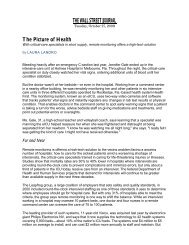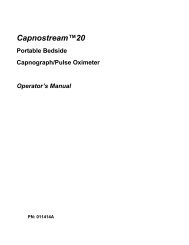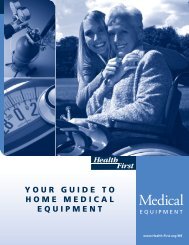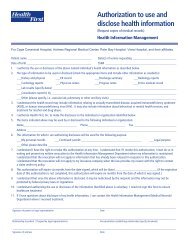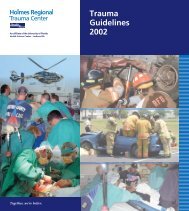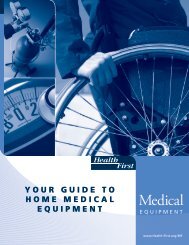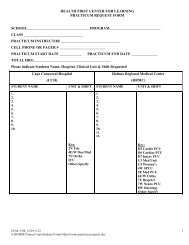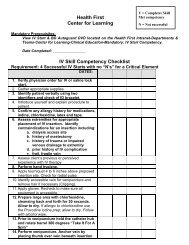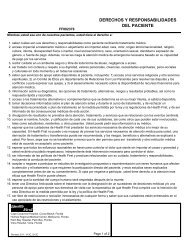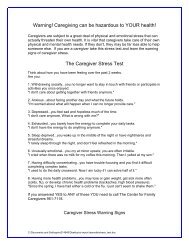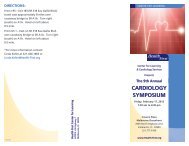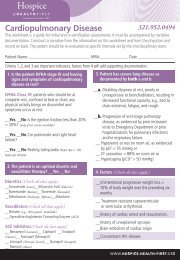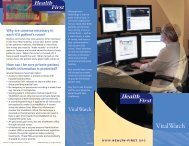Anticoagulation Pharmacotherapy Update 2012 - Health First
Anticoagulation Pharmacotherapy Update 2012 - Health First
Anticoagulation Pharmacotherapy Update 2012 - Health First
Create successful ePaper yourself
Turn your PDF publications into a flip-book with our unique Google optimized e-Paper software.
<strong>Anticoagulation</strong> <strong>Pharmacotherapy</strong> <strong>Update</strong> <strong>2012</strong>Norman Tomaka, BS Pharm, CPh, LHRM
Speaker Background– Pharmacist (many years…..)– Consultant Pharmacist (a long time…..)– Licensed <strong>Health</strong> Care Risk Manager-Past Chairman, Board of Directors-Past President Florida Pharmacy Association– Previous educational program affiliations includeElan Biopharmaceutical,Florida Pharmacy Association, Florida Society of<strong>Health</strong> System Pharmacists and theUS Board of Pharmaceutical Specialties
Speaker DisclosureI do not have a vested interest or anaffiliation with any corporation ororganization offering financial support orgrant monies for this seminar.I do not have an affiliation with anyorganization whose philosophy couldpotentially bias this presentation.
SpecialAcknowledgmentThanks to Steve Gilbert, Pharm.D.Clinical Pharmacist CoordinatorHolmes Regional Medical CenterMelbourne, FL
ObjectivesAt the end of the presentation, the attendeewill be able to:• Discuss medications that are FDA-approved for AtrialFibrillation and DVT Prophylaxis• Identify three benefits associated with new therapies• Distinguish patients that may be appropriate candidates fornewer drugs instead of conventional pharmacotherapy• Review emerging and less understood nuances associated withnew anticoagulants
The “Ideal” Anticoagulant• Oral• Once daily• High efficacy• Predictable doseresponse / kinetics• Low bleeding risk• No routinemonitoring• Wide therapeuticindex• No dosageadjustments• Minimal drug/foodinteractions• Low protein-binding
Anticoagulant Timeline• 4 th Century BC – Hippocrates proposes an oral blood thinner• 10 th Century AD – Medicinal leeches replacephlebotomy as a method ofanticoagulation• 1860 – Rudolf Virchow presents his “triad of factors”• 1884 - Hirudin is found in the saliva of medicinal leeches• 1916 – Heparin, the first anticoagulant, is discovered• 1939 – Dicoumarol is discovered as the first oralanticoagulant by Karl Link and colleaguesphotos courtesy of sciencephoto.com
http://tpx.sagepub.com/content/35/2/208/F1.expansionVirchow’s Triad
Anticoagulant Timeline cont.1948 – coumarin derivative #42 is named warfarin and is madeavailable as a rodenticide• 1951 – Warfarin becomes available for clinical use and isapproved in 1954• 1980s-90s – Low Molecular Weight Heparins are discovered andput into clinical practice• 2001 – Fondaparinux (Arixtra®) becomes the first anti-Xa specificinhibitor• 2010 – Dabigatran (Pradaxa®) is the first new oral anticoagulantto be approved in nearly 60 years• 2011 – Rivaroxaban (Xarelto®) is the second new approved oralanticoagulant; its mechanism of action is akin to Arixtra®
Primary Mission: PreventionAgents for the Atrial Fibrillationambulatory patientaspirinwarfarin dabigatran rivaroxaban
Aspirin• Higher dose recommended than forsecondary prevention (75-325 mG PO Daily)• <strong>First</strong> line in patients < 75 years of age with noadditional risk factors for cardioembolicstroke• May consider use in patients who are 65-74years of age with 1 moderate risk factor
Warfarin (Coumadin®/Jantoven®)-The first oral anticoagulant approved to prevent/treatvenous thromboembolism (VTE) and embolic stroke-Dosed once daily– Wide range of doses: 0.5 - >20 mG per day-Monitoring:– Dose adjustments made based on INR• Goal 2-3 in most cases, occasionally higher or lower– Signs and symptoms of bleeding, VTE and stroke
“Wild Warfarin” Interactions• Vitamin K Vitamin K– Antagonizes the effects of warfarin– Common foods high in Vitamin K include:• Spinach• Broccoli• Kale• Collard Greens• Soy Products• Other Dark Leafy Vegetables– Consistent dietary intake is most important!-Other factors:-Drug interactions-Physical stress-Activity levels
Dabigatran etexilate mesylate• CLINICAL TRIALS EVIDENCE• RE-LY• PETRO• RE-MODEL• RE-NOVATE• RE-MOBILIZE• BISTRO I• BISTRO II• RE-COVER
Dabigatran etexilate (Pradaxa®)• <strong>First</strong> oral anticoagulant approved in 56 years• A direct inhibitor of Free and BoundThrombin• Similar mechanism of action to Argatroban®,Refludan®– Prevents thrombin from converting fibrinogen tofibrin which decreases platelet aggregation andclot formation
Dabigatran Outcomes• Studied in the >18,000 patient Re-LY trial• Efficacy:– Study designed only to show “equivalency to warfarin”, but showedthat 150 mG PO BID was superior to warfarin in terms of preventinga stroke or systemic embolism– Higher rates of Heart Attack seen in dabigatran arms – unclear asto why• Toxicity:– All general side effects similar to warfarin except ⇑ dyspepsiawith dabigatran– Bleeding:• Similar in major bleeding• Dabigatran better with intracranial and life-threatening bleeding• Warfarin better with gastrointestinal bleedingConnolly SJ et al. N Engl J Med. Sept. 17, 2009;361(12):1139-51.
Cumulative OutcomesConnolly SJ et al. N Engl J Med. Sept. 17, 2009;361(12):1139-51.
FDA Approval• Lengthy process to assure safety• Approved for the prevention of strokeor systemic embolism in patients withnon-valvular atrial fibrillationApproved dosage:• CrCl > 30mL/min: 150 mG PO BID• CrCl 15-29mL/min: 75 mG PO BID• CrCl < 15mL/min: Contraindicated
Dabigatran dose• Are the following doses acceptable?– 150 mG PO Once daily– 75 mG PO BID in a patient with good renalfunction?– 75 mG PO QAM, 150 mG PO QPM
Monitoring Dabigatran• Monitoring is not recommended by the FDA– Consider checking a complete blood count and astool sample for blood periodically• Serum creatinine to evaluate renal function• To assess bleeding risk for pending surgery:– Ecarin Clotting Time– aPTT– INR – not effective marker!Practical-Haemostasis.com
Dabigatran and Surgery – Pre-opRenal functionEstimated half-lifeStop dabigatranStop dabigatran(CrCl, mL/min)in hoursbefore surgeryHigh risk of bleeding*before surgeryStandard risk≥50-80 ~15 (12-18) 2-3 daysbefore24 h prior(2 doses)≥30 to 5 days 2-5 days*https://www.rely-trial.com/RelyWeb/resources/jsp/emergency/surgery.jsp
Dabigatran and Surgery – Post-op• Initiate treatment with dabigatran assoon as clinically indicated usually12-24 hours post hemostasis• If oral medication is not feasible,heparinization intravenously orsubcutaneously should be considered
Converting to Dabigatran• Conversion from warfarin:– D/C warfarin and start dabigatran once theINR is < 2• Converting from a parenteralanticoagulant:– Start dabigatran 0-2 hours before the nextdose of a SQ injection or at the time ofdiscontinuation of an IV Heparin drip
Converting from Dabigatran• Conversion to a parenteral anticoagulant– Start Parenteral anticoagulation:• CrCl ≥ 30mL/min – 12 hours after last dose• CrCl < 30mL/min – 24 hours after last dose• Conversion to warfarin*:– CrCl > 50mL/min – Start 3 days prior to discontinuing– CrCl 31-50mL/min – Start 2 days prior to discontinuing– CrCl 15-30mL/min – Start 1 day prior to discontinuing– *Note: Due to dabigatran’s potential effect on the INR, the INR is not validuntil dabigatran has been stopped for 48 hours.
Overdose / Toxicity• No great answers:– Dialyzable• Risks associated with catheter placement in a patient at ahigh risk of bleeding– Fresh Frozen Plasma and Packed Red Blood Cells• Does not reverse effect, but some benefit fromhemostasis– Vitamin K• Not useful– Recombinant Factor VIIa and Prothrombin ComplexConcentrates (PCCs) no conclusive clinical evidence
Difficult Questions• Chronic CrCl < 30mL/min & 75 mG dose• Acute Renal Failure• Severe Bleeding• Use of thrombolytics or “clot busters”
Rivaroxaban• CLINICAL TRIALS EVIDENCE• ROCKET-AF• RECORD 1, 2, 3, 4• ATLAS-ACS TIMI-46• ATLAS-ACS-2 TIMI-51• ODIXa-DVT• EINSTEIN• MAGELLAN
Rivaroxaban – In the mediaJuly 1, 2011FDA approves oral anticoagulant rivaroxaban for DVT prevention at surgeryJuly 5, 2011FDA readies for rivaroxaban stroke/AF reviewSeptember 7, 2011FDA will argue against rivaroxaban approval for AF indicationSeptember 8, 2011Rivaroxaban should be approved for stroke prevention in AF, panel tells FDASeptember 23, 2011Rivaroxaban: CHMP recommends new AF, DVT indicationsNovember 4, 2011FDA Approves Rivaroxaban for stroke prevention in AF patients
Rivaroxaban (Xarelto®)• The second recently approved oralanticoagulant• <strong>First</strong> Direct Anti-Xamedication• Similar mechanism of action to fondaparinux(Arixtra®)– Selectively blocks the active site of Factor Xa anddoes not require Antithrombin-III for activity.
Rivaroxaban Outcomes• Studied in the > 14,000 patient ROCKET-AF trial• Efficacy: In terms of the primary endpoint of stroke or systemicembolism, rivaroxaban dosed at 20 mG* PO Daily was deemednon-inferior to warfarin.• Toxicity: General side effects relatively minimal. Someincreased risk of elevated liver enzymes.– When compared to warfarin, there was no significant difference inmajor bleeding, however rivaroxaban had a significantly lower riskof intracranial hemorrhage.*Adjusted to 15 mG in patients with CrCl 30-49 mL/minPatel MR, et al. NEJM Sept. 8, 2011;356(10):883-91.
Approvals-Approved to reduce the risk of stroke orsystemic embolism in patients withnon-valvular atrial fibrillation– Approved dosage:• CrCl > 50 mL/min: 20 mG PO Daily with theevening meal• CrCl 15-50 mL/min: 15 mG PO Daily with theevening meal• CrCl < 15 mL/min: Contraindicated
Concerns / Comments• Control Arm: Warfarin was in the therapeuticrange 55% of the time• Dabigatran 110 mG BID non-inferior efficacy withequal safety: not approved• Rivaroxaban’s half-life vs mode of action• What do you do post-surgically in total knee andtotal hip arthroscopy patients with AtrialFibrillation?
Clinical Evidence DifferencesStudy populations were differentDabigatranRivaroxabanPatel MR, et al. NEJM Sept. 8, 2011;356(10):883-91. Connolly SJ et al. N Engl J Med. Sept. 17, 2009;361(12):1139-51.
Clinical DifferencesStudy populations were dissimilarPatient populations are quitedifferent. Inferences between thetwo should be made withcaution!?
Apixaban• CLINICAL TRIALSEVIDENCE• ARISTOTLE• AVERROES• APPRAISE 1, 2• ADVANCE 1, 2, 3RXtimes.com
Apixaban• Not yet Approved in the U.S.• Marketed as Eliquis® in Europe• Merits attention
ARISTOTLEApixaban for Reduction in Stroke and Other Thromboembolic Events in Atrial Fibrillation• Studied against warfarin in > 18,000 patients• <strong>First</strong> new drug to show superiority over warfarinin all 3 of the following:– primary event rate (21% decrease)– bleeding risk (31% decrease)– overall mortality (11% decrease)• Dosing was 5 mG BID, but required adjustmentin ~4% of patients due to potential druginteractionsGranger CB, et al. NEJM Sept 15, 2011;365(11):981-92.
AVERROESApixaban Versus Acetylsalicylic Acid [ASA] to Prevent Stroke in Atrial Fibrillation PatientsWho Have Failed or Are Unsuitable for Vitamin K Antagonist Treatment• Studied against aspirin in ~5600 patients withA-Fib who could not tolerate warfarin• Trial was stopped early because of the profoundbenefit seen (55% decrease in primary events)• Differences in major and intra-cranial bleedingwere not significant• Risk for hospitalization was also decreased inthe first year (3.3% absolute risk, 20.7% relativerisk)Connolly SJ, et al. NEJM March 3, 2011;364(9):806-17
AVERROES Study Population• Primary reasons patients couldn’t take warfarin:– INR unable to be maintained in the therapeutic range– INR measurements could not or were unlikely to beobtained at requested intervals– The risk of stroke was moderate (CHADS2 score of 1)– Patients did not want to take a vitamin K antagonist
Decisions….decisions……• The equation to decide includes:– Risk to Benefit of therapy– Cost of therapy– Patient specific issues– Insurance approval!• Exciting time ahead in the world ofanticoagulation
Pros and ConsFavorable• Dabigatran– Superior Efficacy– Few Drug Interactions• Rivaroxaban– Once Daily– No increased bleeding• Apixaban– Superior Efficacy & Safety– Also may be used inpatients intolerant towarfarinUnfavorable• Dabigatran– ⇑ Incidence of GI Bleeding– Twice Daily• Rivaroxaban– No superiority– Drug Interactions• Apixaban– Twice Daily– Drug Interactions– ? Cost unknownInsurance Approval Process
Patient Characteristics supportingdabigatran or rivaroxaban• Dabigatran– Many unavoidable CYP450 drug interactions– Higher risk patient (superiority data)– Compliance integrity with BID dosing• Rivaroxaban– Intolerance to dabigatran (dyspepsia most common)– History of GI bleed– Need of for once-daily drug: ComplianceInsurance Approval Process
DVT Prophylaxis
AHRQ* CampaignMost hospitalized patients have at least one risk factor*Agency for <strong>Health</strong>care Research & Quality
http://www.crmhealthcare.net/docs/67450a_CapriniRiskAssesemntTool.pdf
Standard of Care• Mechanical Prophylaxis– Compression Stockings– Sequential Compression Devices (SCD’s)• Pharmacologic Prophylaxis– Unfractionated Heparin (UFH)– Low-Molecular Weight Heparin’s (LMWH’s)– Fondaparinux (Arixtra®)– Warfarin (Coumadin®, Jantoven®)
Standard of Care• UFH (Unfractionated Heparin)– 5000 Units Subcutaneously (SQ) Q8º– Alternatively 5000 Units SQ Q12º• LMWH (Low Molecular Weight Heparin)– Dalteparin (Fragmin®) 2500 - 5000 Units SQ Q24º– Enoxaparin (Lovenox®) 30 mG SC Q12º• Alternative 40 mG SC Q24º– Tinzaparin (Innohep®) 75 anti-factor Xa InternationalUnits/kg SC Q12º• Arixtra® 2.5 mG SC Q24º (unique factor anti-Xa inhibitor)• Warfarin – Usually 2.5 mG – 10 mG PO Daily tomaintain a goal INR of 2-3
Rivaroxaban (Xarelto®)• <strong>First</strong> and only* new oral anticoagulantapproved for VTE Prophylaxis• Studied in the RECORD 1, 2, 3 & 4 trials• Only RECORD 4 truly applies topatients in the US*As of 12/11/11
Outcomes• Studied in the RECORD 4 trial: ~3100 patients• Efficacy:– Study compared rivaroxaban 10 mG PO once daily to enoxaparin30 mG SC Q12º in patients under going total knee arthroplasty(TKA). Primary outcome was composite of any DVT, non-fatal PEor death from any cause. Rivaroxaban showed a 32% reduction inevents as compared to enoxaparin.• Toxicity:– All general side effects similar to enoxaparin. The most commonnon-bleeding adverse effects were increase in LFT’s, and “woundsecretion”.– Similar in major bleeding – Low event number (
Clinical Trial Considerations• Based on results from the RECORD 1 – 3 trials, theendpoints were strengthened• Data were short-term: Only 17 days post-surgery– Concern for long-term outcomes?• Can we apply the data to Hip replacement surgery?
Approval• FDA– Approved for deep venous thrombosis (DVT)prophylaxis, which may lead to pulmonaryembolism (PE), in patients undergoing knee orhip replacement surgery– Approved dosage:• CrCl > 50mL/min: 10 mG PO Daily• CrCl 30-50mL/min: 10 mG PO Daily – Observe closely andpromptly evaluate any signs/symptoms of bleeding• CrCl < 30mL/min: Contraindicated
Drug Use and Review• Rivaroxaban at present is only dosed once daily(ACS studies are evaluating a BID low-dose)• A 10 mG dose should always have a pre-definedlimit with no refills– 12 days total therapy post-TKA– 35 days total therapy post-THA• 15 mG and 20 mG:– Chronic therapy for aFib– Encourage monitoring of renal function, especially inthe more elderly population• Not approved for VTE treatment!!– If a patient develops VTE while on rivaroxaban, analternate therapy should be chosen (warfarin).
Clinical Pearls: Rivaroxaban• Rapidly attains therapeutic concentration (2-4 hours)• Drug Interactions:– Rivaroxaban is a substrate for CYP3A4, P-gp and others– Avoid concomitant use with strong inhibitors/inducers– Use caution in patients with CrCl 15-49mL/min taking weakmoderateinhibitors/inducers• Avoid use in patients with moderate-severe hepaticimpairment (Child Pugh Class B or C)• ? Caution in Japanese patients (50% higher levels)
Overdose / Toxicity• No clear-cut answers:-Vitamin K has no utility with new agents– Dialyzable?• Rivaroxaban is highly protein-bound. Not expected to bedialyzable– Fresh Frozen Plasma and Packed Red Blood Cells• Does not reverse effect, but some benefit fromhemostasis– Activated prothrombin complex concentrate and/orfactor VIIa has shown a potential to attenuatehemostasis impairment after rivaroxaban overdose inbaboons, thus providing a possible antidote duringbleeding emergencies*. Further studies are needed.*http://ash.confex.com/ash/2008/webprogram/Paper11857.html
Difficult Questions• Acute Renal Failure– Recommendation to discontinue therapy• Severe Bleeding– Supportive care only• Concomitant use of thrombolytics or“clot busters”– Similar problem to dabigatranunpredictableresponse
Tomorrow’s <strong>Anticoagulation</strong> Therapy?
Other Anticoagulants in thedevelopment “pipeline”• Edoxaban – ENGAGE-AF TIMI 48 Trial• Betrixaban – EXPERT Trial• Otamixaban– SEPIA-ACS 1 TIMI 42 Trial– SEPIA-PCI Trial
References• Agency for <strong>Health</strong>care Research and Quality: Venous Thromboembolism (VTE) Prevention in the Hospital. SlidePresentation from the AHRQ 2009 Annual Conference (Text Version). December 2009. Agency for <strong>Health</strong>care Research andQuality, Rockville, MD. http://www.ahrq.gov/about/annualconf09/Maynard2.htm• Albers GW, Amarenco P, Easton JD, Sacco RL, Teal P. Antithrombotic and Thrombolytic Therapy for Ischemic Stroke:ACCP Evidence-Based Clinical Practice Guidelines (8 th Ed.). Chest. 2008;130:630S-669S.• Bounameaux, H. The Novel Anticoagulants: Entering a New Era. Swiss Med Wkly. 2009;139(5-6):60-64.• Clinical Pharmacology [database online]. Tampa, FL: Gold Standard, Inc.; 2011. URL:http://www.clinicalpharmacology.com. <strong>Update</strong>d July 2011.• Connolly SJ, Eikelboom J, Joyner C, et al. Apixaban in Patients with Atrial Fibrillation. NEJM. March 3, 2011;364(9):806-817.• Connolly SJ, Ezekowitz MD, Yusuf S et al. Dabigatran versus Warfarin in Patients with Atrial Fibrillation. N Engl J Med.Sept. 17, 2009;361(12):1139-51.• Dabigatran Prescribing Information, Boehringer-Ingelheim Pharmaceuticals, 2010.• Granger CB, Alexander JH, McMurray JJV, et al.• Mannucci PM, Poller L. Venous Thrombosis and Anticoagulant Therapy. Br J Haematol. 2001;114: 258-70.• Patel MR, Mahaffey KW, Garg J, et al. Rivaroxaban versus Warfarin in Nonvalvular Atrial Fibrillation. NEJM. September 8,2011;365(10):883-91.• Rivaroxaban Prescribing Information, Janssen Pharmaceuticals, 2011.• Roger VL, Go AS, Lloyd-Jones DM, et al. Heart Disease and Stroke Statistics--2011 <strong>Update</strong>: A Report From the AmericanHeart Association. Circulation. 2010 Dec 15. [Epub ahead of print].• Singer DE, Albers GW, Dalen JE et al. Antithrombotic therapy in Atrial Fibrillation: ACCP Evidence-Based ClinicalPractice Guidelines (8 th Ed.). Chest. 2008;133:546S-592S.• Unpublished Data on File with Boehringer-Ingelheim.• van Ryn J, Stangier J, Haertter S et al. Dabigatran etexilate – a novel, reversible, oral direct thrombin inhibitor: Interpretationof coagulation assays and reversal of anticoagulant activity. Thrombosis and Haemostasis. 2010 Jun;103(6):1-12.• A. Gruber, MD, U.Marzec, Ulf Buetehorn, S. Hanson, PhD4 and E.Perzborn. “Potential of Activated Prothrombin ComplexConcentrate and Activated Factor VII to Reverse the Anticoagulant Effects of Rivaroxaban in Primates .’http://ash.confex.com/ash/2008/webprogram/Paper11857.html
??Questions??Norman.Tomaka@health-first.orgTel:321-434434-31733173
<strong>Anticoagulation</strong> <strong>Pharmacotherapy</strong> <strong>Update</strong> <strong>2012</strong>Norman Tomaka, BS Pharm, CPh, LHRM



